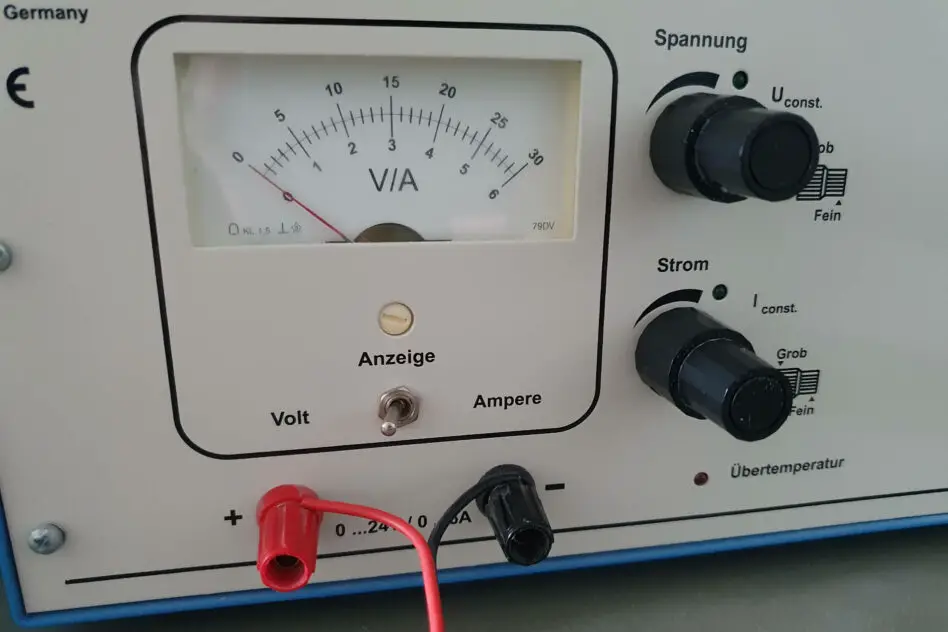The internal resistance of a voltage source is an important parameter in electrical engineering. The internal resistance describes how much the voltage source is actually loaded by the connected consumers.
Here you will find all formulas as well as a practical online calculator for calculating the internal resistance of your voltage source.
Internal Resistance Calculation
To determine the internal resistance of a voltage source, we need to compare the terminal voltage in different load conditions:
Unloaded Voltage Source
If no consumer or load is connected to the source, no current is flowing. In this state, we refer to an unloaded voltage source. The terminal voltage of the source is equal to the open-circuit voltage $U_0$.
To calculate the internal resistance $R_i$ of the voltage source, perform the following steps:
- Measure the open-circuit voltage $U_0$ of your voltage source.
- Load the voltage source with a resistor $R_{L}$ and measure the loaded voltage $U_k$.
Loaded Voltage Source
With a connected load, a current $I$ flows through the circuit. This current is conducted through both the internal resistance $R_i$ and the load resistance $R_L$.
The terminal voltage $U_k$ can now be calculated using the internal resistance $R_i$, the open-circuit voltage $U_0$, and the current $I$:
$$ U_k = U_0 – I \cdot R_i $$
To calculate the internal resistance $R_i$ of your voltage source, rearrange the above equation for $R_i$:
$$ R_i = \frac{U_0 – U_k}{I} $$
When conducting the measurements, ensure accuracy and make sure the voltage source and measuring instruments are properly calibrated. To obtain more accurate results, multiple measurements should be taken to calculate an average value.
Load Resistor Current
The current through the load resistor is calculated using Ohm’s law as follows:
$$ I = \frac{U_k}{R_L} $$
Internal Resistance Online Calculator
You can easily calculate the internal resistance and the current through the load resistor with the following online calculator. Enter the no-load voltage (open-circuit voltage), the loaded voltage, and the load resistance.
Internal Resistance of Various Sources
Real vs Ideal Voltage Sources
In electrical engineering, calculations are often performed with an ideal voltage source for simplification. However, there is an important difference between ideal and real voltage sources.
An ideal voltage source provides a constant voltage regardless of the load, while a real voltage source has an internal resistance that affects the terminal voltage and the delivered current.
The internal resistance $R_{i}$ of a real voltage source causes a voltage drop in relation to the actual load. When a load is connected to the terminals of a real voltage source, the terminal voltage $U_{k}$ deviates from the open-circuit voltage $U_{0}$.
Additionally, the internal resistance depends on other factors such as temperature, material, and construction of the voltage source. These factors need to be considered when designing power supply and circuit designs.
Generator Internal Resistance
The internal resistance of a generator plays a crucial role in ensuring high performance and efficiency. A high internal resistance would result in a significant loss of energy as heat inside the generator. This heat would need to be effectively dissipated while simultaneously reducing the output power.
Internal Resistance of Power Supplies
A low internal resistance in a power supply enables stable voltage delivery without significant voltage drops. This is especially important when the load on connected devices fluctuates greatly.
In switching power supplies and linear voltage regulators, regulation is applied to reduce the influence of the internal resistance.
Battery Internal Resistance
For batteries (and accumulators), the internal resistance is crucial for capacity and thus for a long service life. A low internal resistance allows for higher current output. High-quality batteries (and accumulators) generally have lower internal resistance compared to more budget-friendly variants.
Aim For a Low Internal Resistance
A low internal resistance enables better energy transfer and thus higher efficiency of a voltage source. The smaller the internal resistance, the less voltage drop occurs within the source, making it better suited for supplying electrical devices and circuits.
Therefore, modern power supplies typically have a low internal resistance, resulting in less voltage reduction and more stable operation under various loads.




